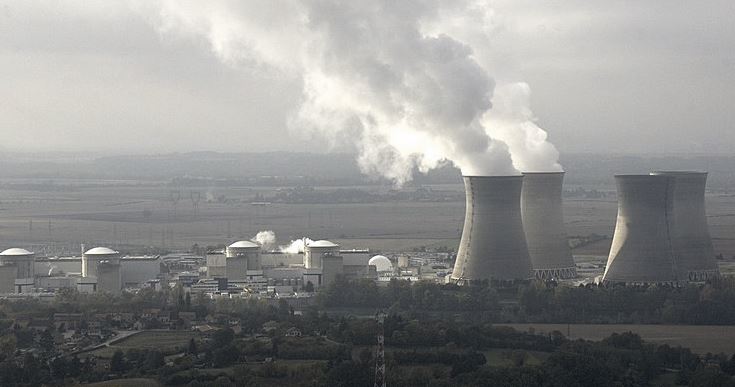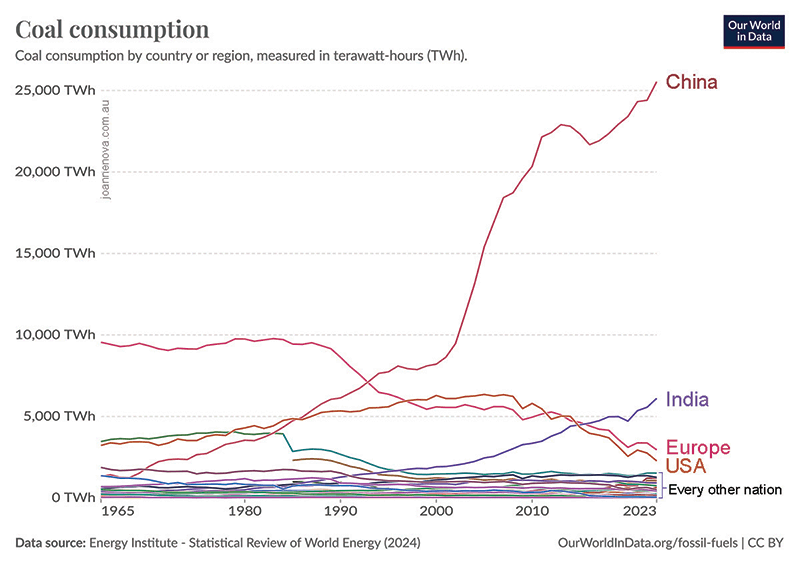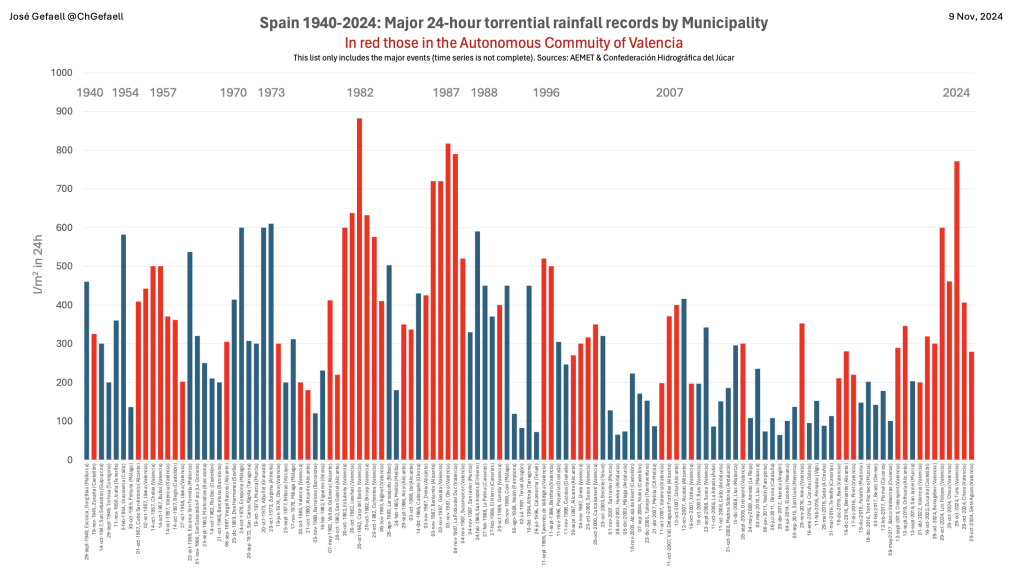|
|
||||
 Photo by Spiritrespect. By Jo Nova Everything just changed. For the first time in Climate Bureaucracy, Nuclear power can save the world too.Until today, only renewables had the Holy Sacred Power against Climate Change. But last night the UK and US signed a new agreement at COP29 to share “billions of pounds worth of nuclear research” in order to “decarbonize” the world. They did this backflip in such a tearing rush, they didn’t even have time to phone the Prime Ministers they were offering this bonanza to. They accidentally listed all the countries they expected to sign up, only to find the Australian government is going to an election waving the anti-nuclear flag, while the opposition demons carry the pro-nuclear pennant. Oopsie indeed. The press release was reissued, but the Labor government in Australia are now trying to explain why nuclear power is great in submarines, but too expensive and slow for sites that don’t move and aren’t underwater. It’s entertaining. Apparently, Australia has too much sunshine, and thus we’re stuck with solar power. We also have the largest uranium reserves in the world, but shh. This is like energy lessons on Sesame Street.
Nuclear power is Kryptonite to RenewablesDon’t miss how big this is. Only a year ago France scandalized the world when they dropped their renewables target and fought the EU to get nuclear power accepted as a “low emissions” generator. They had to threaten to scupper the EU’s new Renewable Energy Directive unless the EU included a role for nuclear power. Renewables groupies hate nuclear power, because it’s everything they want to be but aren’t. Nukes are low emissions, reliable, proven, easy to add to a grid, and they don’t need a caravan of batteries, flywheels, hydro-dams or a 1,000 miles of high voltage lines. Obviously, if nuclear power can save the world from the Carbon Yeti, no one needs to build floating bird killers. The implication is that renewables are being quietly thrown under a bus. The Blob is backing away slowly from 30 years of “free energy” propaganda. They have blinked, and switched to nuclear, the same obvious solution they could have picked from the start in Rio in 1992. Be prepared as they gaslight the world, hoping they will forget the trillions of dollars poured into the renewable energy port-a-loo. The Trump factor is already killing sacred cowsThe Blob is clearly tripping at full speed here — reacting to the shift in power with Trump’s win. Ed Miliband may be trying to try to save COP29 from terminal irrelevancy. But the Blob surely knows that the grifter game is up for renewables — now that investors are abandoning them, industries are headed to China, and electricity prices have taken off like one of Elon’s rockets. That and Google, Microsoft, Amazon and Oracle ignored their wind and solar pony showcases and rushed to get nuclear power to feed their pet AIs. For all we know, the new nuclear plan might have been written the day they released it. How much effort would it have taken for Ed Miliband to mention it to Australia’s Energy Minister (Chris-“Blackout”-Bowen). He didn’t even need to phone him. They’re both at Baku. Giving away Nuclear technologyThe UK Government and the US will be giving away nuclear technology, to speed up deployment of civil nuclear power to “decarbonize industry”. The new agreement would start on March 1 2025, and is (was) expected to be signed by Canada, France, Japan, Republic of Korea, Republic of South Africa, China, Euratom [Europe], Switzerland and Australia. Thus it perfectly wedged the Australian government — which agreed to AUKUS, a nuclear sub sharing program, but is also 100% committed to a Glorious Renewable Future. The US and UK obviously assumed their AUKUS partner would leap at the chance. Instead the updated press release dropped the list of nations.
The Australian Energy Minister, clearly caught unprepared, said “No”
…and, we have too much sun.
For baffled foreigners, the next election in Australia has to be held by May 2025, and looks like it will hinge on nuclear power, which is currently banned in Australia, (largely by accident — because of an incidental Green ten-minute amendment in 1998). Our slow moving Labor diehards were already glued to the renewables-train but the opposition is making nuclear energy a key part of their platform. Polling suggests Australians are not anti-nuclear, but they are anti-electricity-bill-bonfires. So voters seem to find the idea of change appealing. Ed Miliband, of course, is still raving in a hollow rehearsed way about the unreliable transition, but it is a simple fact that the more nuclear power a grid has, the less wind and solar it wants. In the new world order of Trump — The Australian Labor Party may be the last man standing on unreliable renewables.
By Jo Nova Finally, twenty years too late, Australian leaders are talking about the galactic cost of making a spare energy grid that might, maybe, hopefully one day reduce world temperatures by one thousandth of a degree. Sadly they are still not talking about why that’s a pointless quest, why CO2 feeds the poor, warmth is good, humans emissions are irrelevant, or how science has become a turgid swamp patrolled by dead sacred cows. But it’s a start! We got the trifecta: Our car-crash energy bills, the revolution of common sense in the US, and the appearance of our own election on the horizon have set off the Air-raid sirens to wake a sleeping nation. It’s only half a trillion dollarsThe Minister for Energy says the cost of renewables by 2050 will be $122 billion (AUD). Not convinced, the Opposition commissioned a study that estimates it’s more like $650 billion. But what’s a half a trillion dollars when you have hope, faith, and a fantasy to make storms a bit nicer? It’s a horror show. The Labor Government wants every family of four to spend something like $100,000 on their wind and solar vision over the next 25 years. There goes the house deposit, the uni fees, the family holidays. There goes our lifestyle. Australian energy is twice the priceThings are so bad here in Renewable Crash Test Dummy World, that the CEO of Glencore said Australian energy costs twice as much as in the US, Canada, China and India. Glencore, is the largest coal miner in Australia, the fifth largest miner in the world, and employs about 140,000 people. Gary Nagle went on to tell the Daily Telegraph that Australia has a bad attitude: He argued that the negative attitude to coal in Australia was increasingly out of step with other parts of the world. “Many stakeholders globally are now taking a more pragmatic view about coal,” Mr Nagle said. It’s such a first world problem. Imagine being the world’s largest coal exporter nation every other year, and spending billions to undermine one of your two largest industries? How did we get here, standing on a plank, sawing the ship off? Tricked by “free energy” scamThe electricity-fashion-queens chased a vision of fairy-energy so they could win cat-walk parades at the UN, but lose in every other race that matters. The wind and sun appear to be free, but cost us the Earth to collect, and the Universe to store. All the politicians had to do was get scientists and engineers to debate in public and they would have realized that they can’t keep electricity in a shoe-box, or post it from the Simpson Desert to Sydney harbor. Instead, they employed the yes-men who agreed with the vision, and sacked, silenced or never funded the 1,000 engineers who could have told them it was stupid. That, and they all watched the ABC: Bowen, others should be ashamed of our $650bn renewables disasterRobert Gottleibsen, The Australian Since Federation, Australian ministers on both sides of the parliament have made major mistakes and misleading statements. But nothing in our history matches the looming renewable energy conversion financial disaster. The Bowen calculations are based on “net present value”, or NPV, which involves calculating the final cost and adjusting it back to the current dollars. But commercial infrastructure projections work on what will actually be outlaid. Frontier have now done those outlay calculations to 2050 for the governments and now the public. And of course, by 2050 all the windmills and sacred glass panels will be due to expire and we will need to find a very big hole to bury them in, and start again with the fire-hose from the bank account spraying direct to China. The only hope, as Gottleibsen says, is if the protests from farmers and country towns have glued up the plans enough that we can pull the pin before we sink any more into this pit. It only makes sense if imaginary “carbon credits” had some value: So, the state and federal governments devised a system which I would call “rigging the books”. But they would justify it by saying carbon savings had a value which must be counted in the project. And so, a transmission network hypothetically costing $100m would be given a carbon credit, which would reduce its “cost” substantially and justify investment. Frontier calculates that some $80bn of the $650bn came from these carbon credits. And this half a trillion doesn’t include half the country (the Western half and the Northern Territory). The price can only rise. Despite the blockbuster costs, Frontier Economics have almost certainly underestimated the true cost of converting Australia into a third-world nation. The direct costs are bad, but the secondary costs are existential. Once the factories and mines are gone, who is left to defend the green-god ideology? By Jo Nova It’s a war on The BlobTrump has endorsed the man they call the anti-vax conspiracy theorist, the one who wrote the book accusing Anthony Fauci of abusing his power for thirty years. (Something Fauci has not sued him for). RFK Jr has relentlessly criticized the CDC, the FDA, and the NIH for more than twenty years, while they’ve mocked him and refused to give him the data, and now he’ll be in charge of them. This move has been telegraphed for months, and happened exactly as promised, yet shares in vaccine makers GSK, Moderna, Pfizer, and Sanofi fell three to seven percent today anyhow. It’s a moment of master trolling. The far right extremist Donald Trump has put a Democrat environmentalist in charge of health and told him to “Go wild”. Despite the so-called “controversy” of this decision, everyone seems to have forgotten that only six weeks ago the former head of the CDC, Robert Redfield, admitted that Trump and Kennedy were both right. In a blockbuster Newsweek article, the man Kennedy had criticized said: “All three of the principal health agencies suffer from agency capture”. “A large portion of the FDA‘s budget is provided by pharmaceutical companies. NIH is cozy with biomedical and pharmaceutical companies and its scientists are allowed to collect royalties on drugs NIH licenses to pharma. “Donald Trump Has a Plan to Make America’s Children Healthy Again. It’s a Good One.” Trump, he said, “has chosen exactly the only person who can do this, Robert F Kennedy, Jnr.” Staff within the CDC and FDA are so concerned about decisions to vaccinate babies, but afraid to speak up, they say “It’s like a horror movie I’m being forced to watch”. Government institutions have been rotting for decades. Way back in 1969 the retired FDA Commissioner Dr Herbert Ley warned us: “The FDA protects the big drug companies… and attack those who threaten the big drug companies. People think that the FDA is protecting them. It isn’t.” ” Ley stated that he had “constant, tremendous, sometimes unmerciful pressure” from the drug industry” Kennedy’s core point — there were no placebo controlled studies before licensing any of the 72 childhood vaccinesAs Kennedy says in the video below: Every other medication requires that the company performs a safety trial that compares health outcomes and placebo group and a similarly situated vaccine group. My assumption was done for vaccines, but we found out that they weren’t. To simply get this answer he had to ask for the data, get publicly scorned, sue the HHS, and it took a year of litigation to get a letter confirming they were not able to locate a single trial. These are zero liability vaccines.
Kennedy is such a radical he thinks it’s a problem that nearly one in every five teenagers has fatty liver disease, one in four women are on anti-depressants, 40% of teens have a mental health diagnosis, and fifteen percent of high schoolers are on amphetamine. In other words, he’s as mainstream as anyone in health could get.
Luckily, there is a solution for Trump Derangement Syndrome: (Don’t stop at the logo, there’s more.)
Wow. The rise of AI satire. One day we will wonder how we filled 24 hour television with no AI.
By Jo Nova In the annual tournament for cash handouts, the UN now enables charity for space-faring nations with slaves. Somehow, the demands for climate reparations were led by the nation burning more coal than the rest of the world combined, and no one laughed, or wondered whether they should mention it. … a group of 77 developing countries, led by China, called for $US1.3 trillion a year in new, additional, adequate and affordable finance to address mitigation, adaptation and loss and damage. –-Graham Lloyd, The Australian It’s almost as if the CCP invented the UN definition of “developing” as an industrial weapon.  ….OWID
Like most developing nations, two weeks ago China launched a manned spacecraft with propellants made from natural gas, and coal because it could not afford to use solar panels and windmills. For the moment, the world’s poor have to settle for using unsymmetrical dimethylhydrazine (UDMH) and nitrogen tetroxide (N2O4) to get their citizens in orbit. China’s space exploration plans include bringing back the first samples from Mars, and from the near-Earth asteroid Kamo’oalewa, and to look for ice in craters on the moon. What’s the point when we call a nation “developed” — when it wrecks its own electricity grid?  Photo by Colin Maynard By Jo Nova Imagine we were spending $200 million to inject pregnant women and vaccinate babies against RSV, and the real cause of many of the life threatening cases was just low vitamin D? RSV (Respiratory syncytial virus) is something nearly everyone catches by the time they are two years old. It’s like a bad cold. We’ll go on to catch it every few years for the rest of our lives, and it’s really only a problem for babies and the very old. In the last week by some odd coincidence, the BBC, ABC and CBC all have stories promoting the idea of saving babies with RSV vaccines which often cost $300 dollars each (USD). The government rollouts are being promoted with free advertising on news programs that pretend to be journalists. But not a single journalist asked the obvious question — if most babies recover just fine, what is different about the babies that struggle. Could it be that low vitamin D puts them at risk? Two studies suggest that babies with low vitamin D are, by golly, 5 to 10 times more likely to need intensive care.Back in 2011, Belderbos et al looked at 158 babies and measured the levels of vitamin D in their cord blood and found those with low levels went on to have six times the risk of a severe lung infection compared to babies with normal levels. (Low was <50 nmol/L (20 ng/ml) and normal was 75 nmol/L (30 ng/ml). It was a small study but other studies at the time already showed vitamin D played a major role in stopping the inflammatory responses getting out of control. By 2022, another study on 125 babies showed that the amount of virus each child had didn’t predict how severe their infection would be, but their vitamin D level when they arrived in hospital did. Those with the lowest vitamin D had a ghastly 11 fold increase in odds of suffering a life threatening illness. (Again low means <50nmol/L (20ng/ml)). If 20% of babies are deficient in Vitamin D, and the 11 fold risk is not just an artefact, that means about half of the babies suffering a life threatening disease are struck down because of their deficiency. Maybe this is a gross overestimate, but where are the studies? Why aren’t our Ministers for Health launching big programs to figure it out? Even if the risk is only 50% more, these are actual babies we’re talking about. And if we get the MAD misinformation laws, will anyone even be able to ask these questions?Critics might be damaging confidence in “public health”. Crazy people might think that if our Healthcare system was trying to save babies, rather than generate profits for Big Pharma (or Big Hospitals) the first thing they would do is study and fix the vitamin D deficiency. It’s not like this is an endangered animal or an exotic disease. It’s not a stretch to say every winter babies are dying because our health departments have little interest in vitamins or saving lives cheaply. To give some idea of how many people this affects — in Ireland during winter about a third of all babies would be classified as deficient. But in sunny-country Australia, it’s hard to even find published numbers. Despite the blazing sun here, about a quarter of adults still have a deficiency, so there’s probably plenty to go around in baby-world. Where is the cost benefit comparison?The long term side effects of injecting pregnant women with a new type of therapy are completely unknown. The side effects of higher Vitamin D levels though, correlate with lower rates of cancer, diabetes, high blood pressure, asthma, heart disease, dental caries, preeclampsia, autoimmune disease, depression, anxiety, and sleep disorders. Vitamin D influences over 200 genes — it is a chief meddler of molecules. Not only are deficient babies at risk of going down to RSV in a bad way, they’re at risk of autism spectrum disorder, behavioral disorders, schizophrenia, depression, and multiple sclerosis [Rogers et al]. As it happens, Vitamin D deficiency may cause as many as 40% of respiratory deaths in older people and one in six dementia cases. People deficient in Vitamin D are 14 times more likely to get severe forms of Covid. Vitamin D reduced intensive care by 80%. Despite all this low-hanging fruit littering the floor of hospitals, and vaporising dollars out of our medicare pot, Ministers apparently don’t want to know? In the UK, Ontario and Australia the vaccine is free (or will be by next winter) for pregnant women and people over 75, but you’ll have to pay to get vitamin D (which doesn’t cost much). But you’d think if we have “free $300 injections” we could have free bottles of vitamin D3 at every post office and school? In Australia, the government is paying $174 million for the vaccines, they call it “investing”. They argue that otherwise about 12,000 babies will be hospitalized each winter. But it only makes sense if we don’t “accidentally” make those babies healthier and keep them out of hospital in the first place doesn’t it? And since you are wondering, yes, there is a new mRNA vaccine for RSV (by Moderna). There are also a couple of protein based ones. Where’s the informed choice? Imagine if pregnant women were also given information on the risks of being low in Vitamin D? At the moment, we’re barely even studying those risks, possibly so Ministers can say “there’s no evidence there is a better alternative.” It’s like the last thing our health system wants is good data on cheap alternatives. REFERENCESBelderbos ME, Houben ML, Wilbrink B, Lentjes E, Bloemen EM, Jan L et al. Low vitamin D levels linked with RSV infection. Pediatrics 2011;127: e1513–20. – PubMed , Pediatrics, 2011 Jun;127(6):e1513-20. doi: 10.1542/peds.2010-3054. Ferolla et al. (2022) Serum Vitamin D Levels and Life-Threatening Respiratory Syncytial Virus Infection in Previously Healthy Infants,” The Journal of Infectious Diseases in 2022.
By Jo Nova Oh the Dilemma?More than 219 people have drowned and another 80 are still missing after the devastating floods in Valencia, Spain. The UN expert climate scientists say that shutting coal plants and building windmills is the best way to stop floods. Matt Ridley is wondering if removing 133 dams had anything to do with it, or if perhaps they should have built the big dam that was approved in 2001 but stopped by the Socialists in 2004: Dam shame: what really caused Valencia’s floods?Matt Ridley, The Spectator … Valencia had a similarly terrible flood in 1957, in which 81 people died, long before climate change became the go-to excuse for any bad weather. After that flood, to prevent a recurrence, the Spanish government built a string of dams in the hills to hold back water and diverted the Turia river away from the city. For more than six decades the system worked well. Why did it fail this year? Because the unusually warm sea made for an unusually bad storm, say some. Yet charts of rainfall in Spain show no trend towards a higher frequency of more extreme downpours… Indeed, 24 hour torrential rainfall records back to 1940 don’t sing the Climate Change song. Since 1982 human emissions of CO2 have grown from a cumulative total of 640 billion tons up to 1,800 billion tons and it hasn’t made the slightest difference to downpours. That’s a 280% increase in man-made CO2 and there’s nothing to show for it. Matt Ridley points to the enthusiastic dam removal programs the EU has been ordering: In the past few years, the Spanish government has been removing dams at a furious rate. Under a European Union programme to encourage the restoration of rivers to their wild state for the benefit of fish migration, Spain set about dismantling barriers of all kinds. In 2021 it got rid of 108 dams and weirs; in 2022, another 133. That year, according to Dam Removal Europe, a coalition of seven green pressure groups, it was Europe’s proud league champion at dismantling them… The billionaire’s ski club called the WEF brags about how many dams they have removed: The removal of dams in Europe is reviving rivers and boosting biodiversity The BBC was touting the environmental wonders of dam removal in Europe only 6 months ago: They not only cause biodiversity loss, impacting fish and microorganisms, but also prevent nutrients and sediments from flowing downstream, hindering fisheries and the livelihoods that depend on them. Research now shows that at least 1.2 million instream obstacles block river flows in 36 European countries, with about 68% less than 2m (6.6ft) in height. “Even barriers as small as 20cm (8in) may impact or delay the movement of some organisms,” says Carlos Garcia de Leaniz professor in Aquatic Biosciences at Swansea University and coordinator of Amber, a project that created the first atlas of European river barriers. Some dams are sacred though — no bureaucrat is going to get rid of a hydro-dam. They stop floods by reducing human CO2 emissions which may in a thousand years, slightly reduce world temperatures in such a way as to change jet-streams, and maybe possibly, lessen the intensity of downfalls. Screw the fish eh? Acknowledging that dams have a detrimental effect on ecosystems doesn’t mean denying hydropower’s benefits in supplying energy, however. “Absolutely nobody is proposing to blow up or remove barriers which are in use,” clarifies Garcia de Leaniz… But as Matt Ridley notes, the Cheste dam was “was specifically designed to prevent flooding, to ‘regulate the flows coming from the upper basin of the Poyo and Pozalet ravines’.” It was abandoned in 2004. “Could it have saved Valencia?” he wonders, pointing out that “the city of Aragon was saved last month by a dam built by the emperor Augustus.”
 Image by Julius H. By Jo Nova Like rats jumping on to a burning ship, the Australian Labor Govt picks the worst possible momentToday the Australian Senate will consider whether to put the Labor MAD Misinformation bill into law, which will give government bureaucrats at ACMA the right to use draconian fines on “digital communications platform” (blogs and Social Media) that publish opinions the high priest bureaucrats don’t like. And they are rushing it through so they can shut down or scare off critics before the next election. They only need to win over three more Senators out of six independent ones. They should all be aware of how corrupt and stupid this will look. See details below on which Senators to write to. Trump takes a warhammer to the censorship cartelThe censorship reached peak-absurdity when the left-wing-corporate-deep-state cartel shut down the US President’s Twitter account. The First Amendment was vaporized. Government officials had told Twitter and Facebook to censor political opinions they didn’t like. Since the FBI-CIA-State-Department have the money, the spies, the army and the assassins, the tech giants complied. The social media corporations also needed the government legal immunity of Section 230, which protects them from liability. Like a post office delivering poison letters — the Tech Giants couldn’t be blamed for what people posted. But Post Offices are supposed to deliver every letter, and the Tech Giants were allowed to read the mail and toss out what they didn’t like. Imagine if US Post decided just to lose Conservative letters, and not even tell them? That’s what shadowbanning is. And thus and verily, a horrible trillion-dollar-monster was welded together, and this response below, wow. What a blockbuster speech:
Thanks to @SpartaJustice for the transcript: ENDING THE CENSORSHIP CARTEL: If we don’t have Free Speech, then we just don’t have a Free Country. It’s as simple as that. If this most fundamental right is allowed to perish, then the rest of our rights and liberties will topple just like dominos one by one. They’ll go down. Trump will cut off the money flow to government agents to censor Americans. FIRST, within hours of my inauguration, I will sign an executive order banning any federal department or agency from colluding with any organization, business, or person, to censor, limit, categorize, or impede the lawful speech of American citizens. I will then ban federal money from being used to label domestic speech as “mis-” or “dis-information”. Then he will sack anyone involved in domestic censorship: And I will begin the process of identifying and firing every federal bureaucrat who has engaged in domestic censorship, directly or indirectly, whether they are the Department of Homeland Security, the Department of Health and Human Services, the FBI, the DOJ, no matter who they are. He will use the full force of the law: “Preserve those emails” SECOND, I will order the Department of Justice to investigate all parties involved in the new online censorship regime… These include possible violations of federal civil rights law, campaign finance laws, federal election law, securities law, and anti-trust laws, the Hatch Act and a host of other potential criminal, civil, regulatory, and constitutional offenses. He will cut off legal protection for any platform that curtails legal speech: From now on, digital platforms should only qualify for immunity protection under Section 230 if they meet high standards of neutrality, transparency, fairness, and non-discrimination. Then he’s going after universities that drive the censorship labels — they will lose funding for research and students for five years or more! FOURTH, we need to break up the entire toxic censorship industry that has arisen under the false guise of tackling so-called “mis-” and “dis-information.” The federal government should immediately stop funding all non-profits and academic programs that support this authoritarian project. If any U.S. university is discovered to have engaged in censorship activities or election interferences in the past, such as flagging social media content for removal and blacklisting, those universities should lose federal research dollars and federal student loan support for a period of five years, and maybe more. There will be criminal penalties for any federal bureaucrat found to interfere with elections by depriving Americans of information: We should also enact new laws laying out clear criminal penalties for federal bureaucrats who partner with private entities to do an end-run around the Constitution and deprive Americans of their First, Fourth, and Fifth Amendment rights. In other words, deprive them of their vote. And once you lose those elections and once you lose your borders like we have, you no longer have a country. He will stop government employees from profiting by quitting their job and moving to a Big Tech platform: Furthermore, to confront the problems of major platforms being infiltrated by legions of former Deep Staters and intelligence officials, there should be a 7-year cooling-off period before any employee of the FBI, CIA, NSA, DNI, DHS, or DOD is allowed to take a job at a company possessing vast quantities of U.S. user data. He’s calling for a digital bill of rights, where people have a right to be treated equally online: FIFTH, the time has finally come for Congress to pass a digital Bill of Rights. This should include a right to digital due process, in other words, government officials should need a COURT ORDER to take down online content, not send information requests such as the FBI was sending to Twitter. Furthermore, when users of big online platforms have their content or accounts removed, throttled, shadow-banned, or otherwise restricted no matter what name they use, they should have the right to be informed that it’s happening, the right to a specific explanation of the reason why, and the right to a timely appeal. In addition, all users over the age of 18 should have the right to opt-out of content moderation and curation entirely, and receive an unmanipulated stream of information if they so choose. Our quality of life depends upon it: The fight for Free Speech is a matter of victory or death for America and for the survival of Western Civilization itself. When I am President, this whole rotten system of censorship and information control will be ripped out of the system at large. There won’t be anything left. By restoring free speech, we will begin to reclaim our democracy, and save our nation. For Australians, the Senators who may stop our Misinformation bill today are: Senator David Pocock, Jacquie Lambie, Tammy Tyrrell, Fatima Payman, David Van, and Gerald Rennick*. [email protected] | [email protected] | [email protected] | [email protected] | [email protected] | [email protected] | But write to all your key elected representatives — let the Labor party know their deceptive methods are obvious, the legislation is a bomb that our largest most powerful allies will detest. It will be unwound. They need to know, so they don’t sell their souls to win the last three Senators over. *Rennick is obviously a Saint who already opposes this bill and needs our help. Hat tip to David of Cooyal. Thank you to those who served.
By Jo Nova It could be the lamest COP meeting yetEvery year thousands of bureaucrats meet in an exotic location for a UN conference to agree not to solve “global warming”. Next week will be the 29th failure. It is the Olympics of Big Government rorts. This is not just a few hundred climate scientists catching up for a weekend, there are forty or fifty thousand grifters meeting, not just for a few days but for two money-sucking weeks. After they’ve used the tax dollars to get there, they sit around and discuss how they will divvy up the loot, the other tax dollars, called “climate finance”, as if the atmosphere wants a loan.
As it happens, Joe Biden and Emmanual Macron are not going either. It just doesn’t have the social cachet these days in the wake of the US election. This next little story is so emblematic of the corruptocrat blob. A senior member of Azerbaijan’s COP29 team has been caught red handed using the “climate” conference to line up investors in Azerbaijan’s oil and gas fields. The sad truth is, that in terms of the world’s poor, this was probably the most productive event at the conference. In a secret recording a fake Hong Kong investor said he wanted to sponsor the conference but in return needed to discuss “investment opportunities” in local gas fields — ain’t that just the way the whole climate cartel rolls? Everybody pretending to look after the planet, but really looking out for themselves. COP29 chief exec filmed promoting fossil fuel dealsA secret recording shows the chief executive of Azerbaijan’s COP29 team, Elnur Soltanov, discussing “investment opportunities” in the state oil and gas company with a man posing as a potential investor. “We have a lot of gas fields that are to be developed,” he says. The BBC has been shown documents and secret video recordings made by the human rights organisation, Global Witness. However, this is the second year in a row the BBC has revealed alleged wrongdoing by the host government. Where was the BBC for the other 27 conferences? — covering up the crime. The horse-trading starts Monday. But In a shock, Papua New Guinea has pulled out, calling the event a total waste of time. “The last three Cop meetings have gone around in circles, producing no tangible results for small island states. Cop29 will be no different, so Papua New Guinea will not participate at the political level,” Tckatchenko said. Good for you PNG. |
||||
|
Copyright © 2024 JoNova - All Rights Reserved |
||||






















Recent Comments